Strategic Analysis of TESCO: Porter's Five Forces and Recovery Plan
VerifiedAdded on 2023/01/05
|11
|3848
|100
Report
AI Summary
This report provides a comprehensive analysis of TESCO's strategic management practices. It begins by applying M.E. Porter's five forces model to assess the competitive landscape within the retail industry, focusing on factors such as the threat of substitutes, new entrants, competitive rivalry, and the bargaining power of buyers and suppliers. The report then presents a case study approach to identify key challenges faced by TESCO, including employee dissatisfaction, operational issues in international markets, and concerns regarding employee health and safety. A crucial component of the analysis involves the examination of a recovery plan developed by TESCO's CEO, utilizing the Ansoff matrix to explore market penetration, product development, market development, and diversification strategies. The report concludes by discussing risk management strategies to enhance profitability and improve TESCO's overall competitive position.
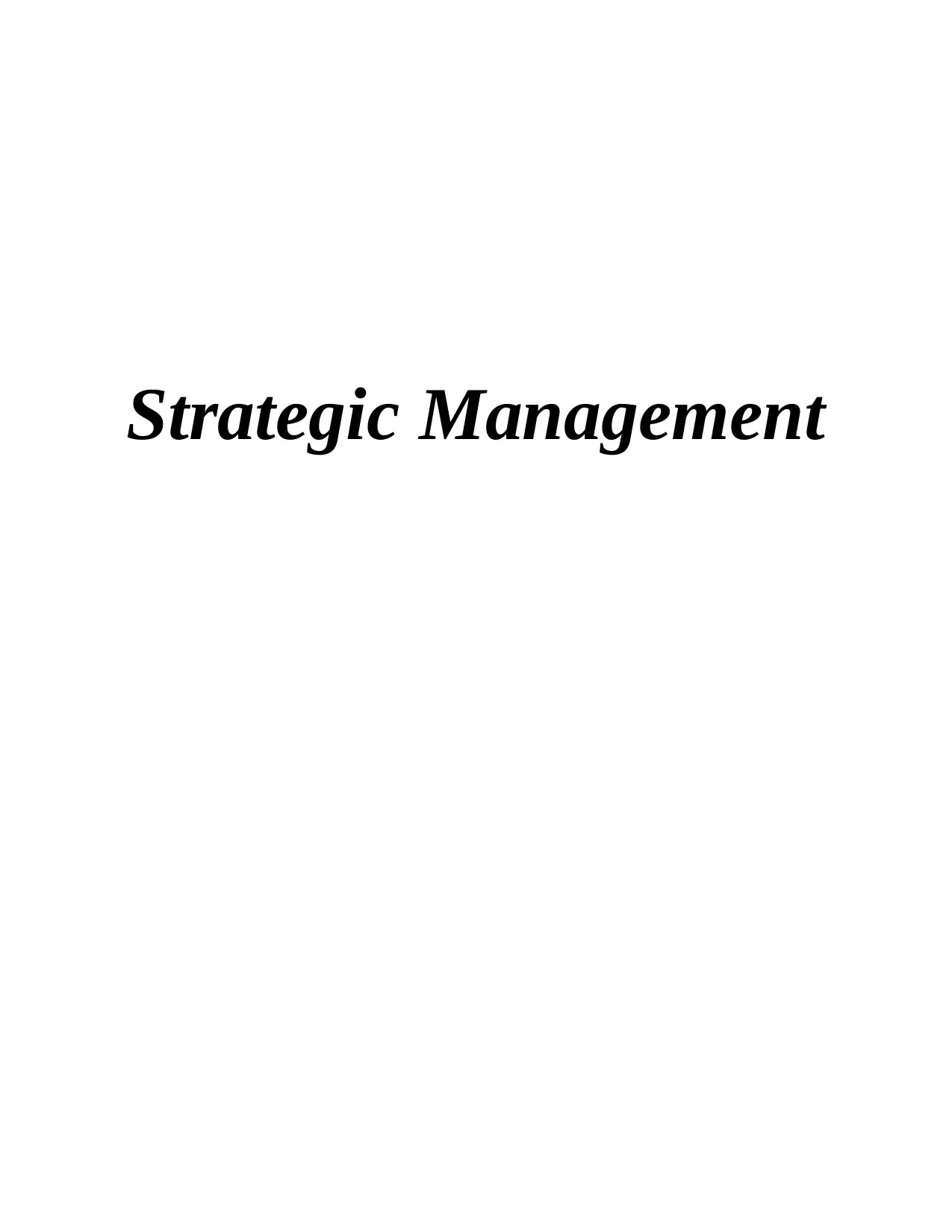
Strategic Management
Paraphrase This Document
Need a fresh take? Get an instant paraphrase of this document with our AI Paraphraser
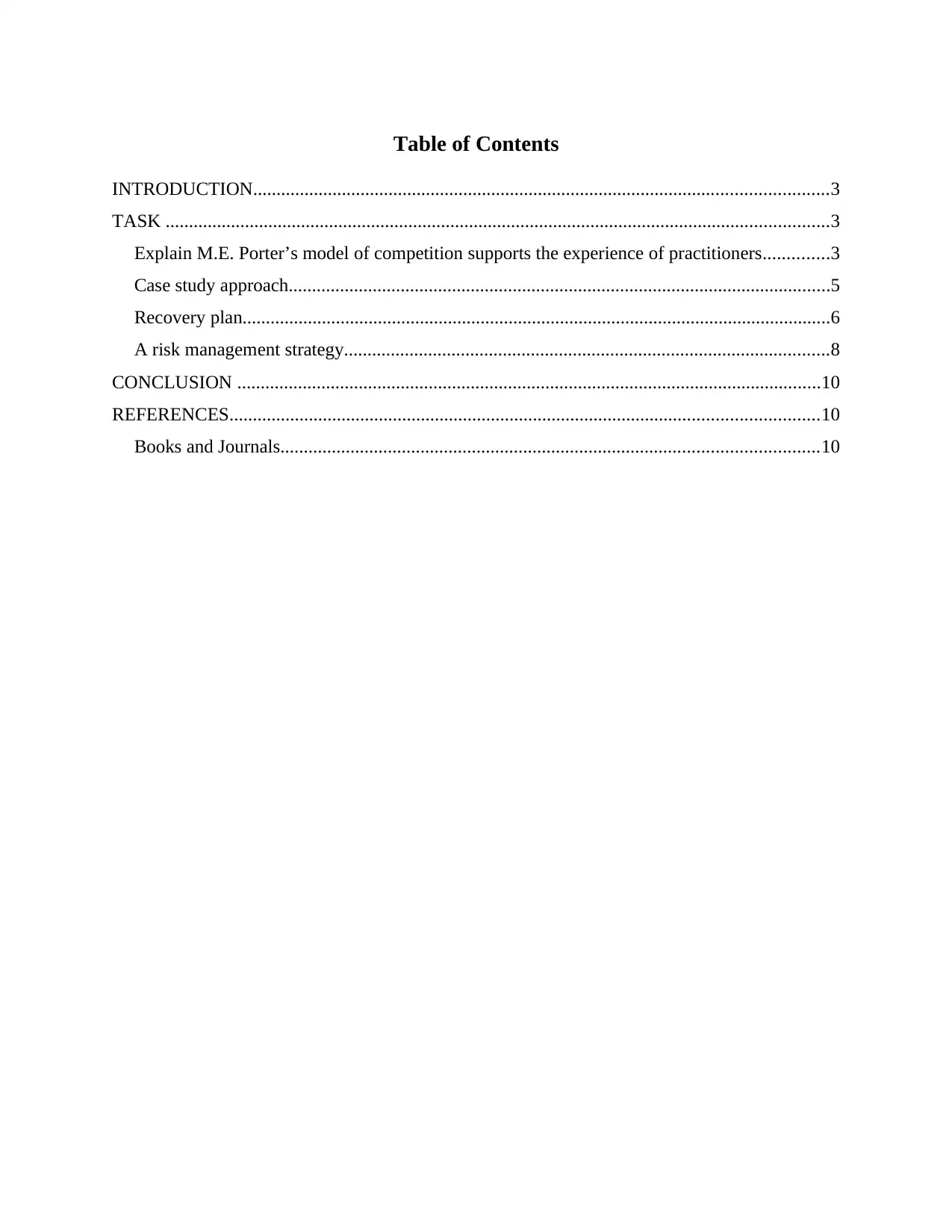
Table of Contents
INTRODUCTION...........................................................................................................................3
TASK ..............................................................................................................................................3
Explain M.E. Porter’s model of competition supports the experience of practitioners..............3
Case study approach....................................................................................................................5
Recovery plan..............................................................................................................................6
A risk management strategy........................................................................................................8
CONCLUSION .............................................................................................................................10
REFERENCES..............................................................................................................................10
Books and Journals...................................................................................................................10
INTRODUCTION...........................................................................................................................3
TASK ..............................................................................................................................................3
Explain M.E. Porter’s model of competition supports the experience of practitioners..............3
Case study approach....................................................................................................................5
Recovery plan..............................................................................................................................6
A risk management strategy........................................................................................................8
CONCLUSION .............................................................................................................................10
REFERENCES..............................................................................................................................10
Books and Journals...................................................................................................................10
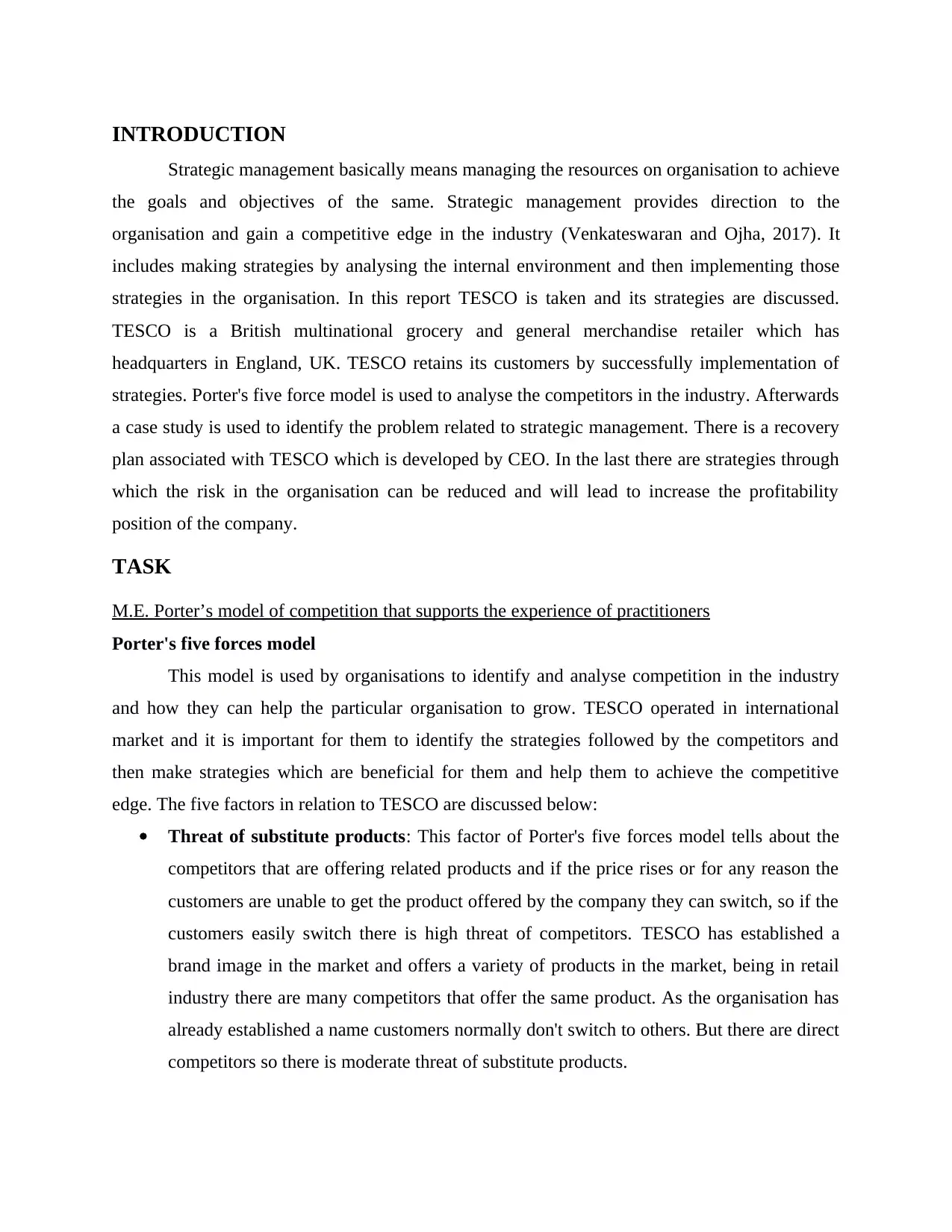
INTRODUCTION
Strategic management basically means managing the resources on organisation to achieve
the goals and objectives of the same. Strategic management provides direction to the
organisation and gain a competitive edge in the industry (Venkateswaran and Ojha, 2017). It
includes making strategies by analysing the internal environment and then implementing those
strategies in the organisation. In this report TESCO is taken and its strategies are discussed.
TESCO is a British multinational grocery and general merchandise retailer which has
headquarters in England, UK. TESCO retains its customers by successfully implementation of
strategies. Porter's five force model is used to analyse the competitors in the industry. Afterwards
a case study is used to identify the problem related to strategic management. There is a recovery
plan associated with TESCO which is developed by CEO. In the last there are strategies through
which the risk in the organisation can be reduced and will lead to increase the profitability
position of the company.
TASK
M.E. Porter’s model of competition that supports the experience of practitioners
Porter's five forces model
This model is used by organisations to identify and analyse competition in the industry
and how they can help the particular organisation to grow. TESCO operated in international
market and it is important for them to identify the strategies followed by the competitors and
then make strategies which are beneficial for them and help them to achieve the competitive
edge. The five factors in relation to TESCO are discussed below:
Threat of substitute products: This factor of Porter's five forces model tells about the
competitors that are offering related products and if the price rises or for any reason the
customers are unable to get the product offered by the company they can switch, so if the
customers easily switch there is high threat of competitors. TESCO has established a
brand image in the market and offers a variety of products in the market, being in retail
industry there are many competitors that offer the same product. As the organisation has
already established a name customers normally don't switch to others. But there are direct
competitors so there is moderate threat of substitute products.
Strategic management basically means managing the resources on organisation to achieve
the goals and objectives of the same. Strategic management provides direction to the
organisation and gain a competitive edge in the industry (Venkateswaran and Ojha, 2017). It
includes making strategies by analysing the internal environment and then implementing those
strategies in the organisation. In this report TESCO is taken and its strategies are discussed.
TESCO is a British multinational grocery and general merchandise retailer which has
headquarters in England, UK. TESCO retains its customers by successfully implementation of
strategies. Porter's five force model is used to analyse the competitors in the industry. Afterwards
a case study is used to identify the problem related to strategic management. There is a recovery
plan associated with TESCO which is developed by CEO. In the last there are strategies through
which the risk in the organisation can be reduced and will lead to increase the profitability
position of the company.
TASK
M.E. Porter’s model of competition that supports the experience of practitioners
Porter's five forces model
This model is used by organisations to identify and analyse competition in the industry
and how they can help the particular organisation to grow. TESCO operated in international
market and it is important for them to identify the strategies followed by the competitors and
then make strategies which are beneficial for them and help them to achieve the competitive
edge. The five factors in relation to TESCO are discussed below:
Threat of substitute products: This factor of Porter's five forces model tells about the
competitors that are offering related products and if the price rises or for any reason the
customers are unable to get the product offered by the company they can switch, so if the
customers easily switch there is high threat of competitors. TESCO has established a
brand image in the market and offers a variety of products in the market, being in retail
industry there are many competitors that offer the same product. As the organisation has
already established a name customers normally don't switch to others. But there are direct
competitors so there is moderate threat of substitute products.
⊘ This is a preview!⊘
Do you want full access?
Subscribe today to unlock all pages.

Trusted by 1+ million students worldwide
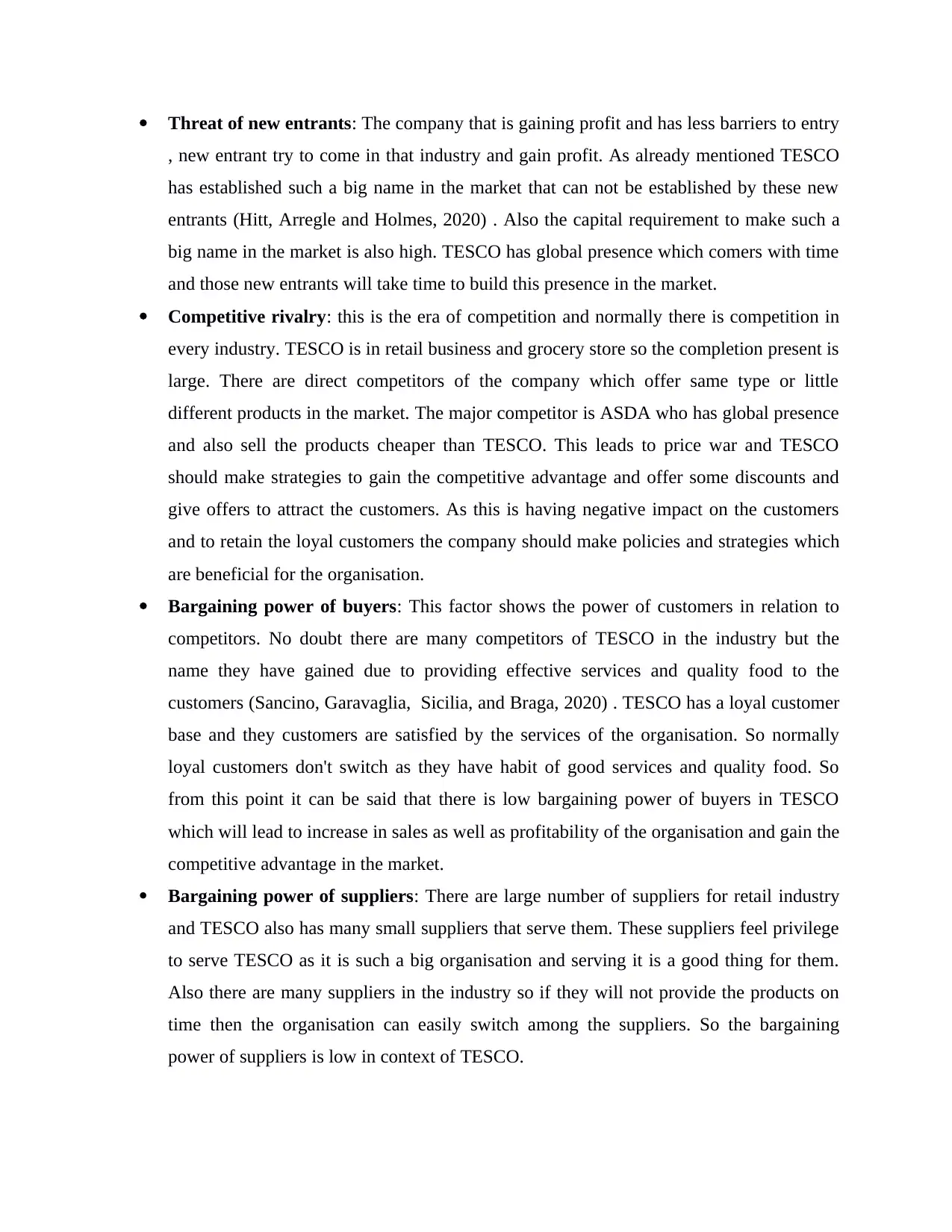
Threat of new entrants: The company that is gaining profit and has less barriers to entry
, new entrant try to come in that industry and gain profit. As already mentioned TESCO
has established such a big name in the market that can not be established by these new
entrants (Hitt, Arregle and Holmes, 2020) . Also the capital requirement to make such a
big name in the market is also high. TESCO has global presence which comers with time
and those new entrants will take time to build this presence in the market.
Competitive rivalry: this is the era of competition and normally there is competition in
every industry. TESCO is in retail business and grocery store so the completion present is
large. There are direct competitors of the company which offer same type or little
different products in the market. The major competitor is ASDA who has global presence
and also sell the products cheaper than TESCO. This leads to price war and TESCO
should make strategies to gain the competitive advantage and offer some discounts and
give offers to attract the customers. As this is having negative impact on the customers
and to retain the loyal customers the company should make policies and strategies which
are beneficial for the organisation.
Bargaining power of buyers: This factor shows the power of customers in relation to
competitors. No doubt there are many competitors of TESCO in the industry but the
name they have gained due to providing effective services and quality food to the
customers (Sancino, Garavaglia, Sicilia, and Braga, 2020) . TESCO has a loyal customer
base and they customers are satisfied by the services of the organisation. So normally
loyal customers don't switch as they have habit of good services and quality food. So
from this point it can be said that there is low bargaining power of buyers in TESCO
which will lead to increase in sales as well as profitability of the organisation and gain the
competitive advantage in the market.
Bargaining power of suppliers: There are large number of suppliers for retail industry
and TESCO also has many small suppliers that serve them. These suppliers feel privilege
to serve TESCO as it is such a big organisation and serving it is a good thing for them.
Also there are many suppliers in the industry so if they will not provide the products on
time then the organisation can easily switch among the suppliers. So the bargaining
power of suppliers is low in context of TESCO.
, new entrant try to come in that industry and gain profit. As already mentioned TESCO
has established such a big name in the market that can not be established by these new
entrants (Hitt, Arregle and Holmes, 2020) . Also the capital requirement to make such a
big name in the market is also high. TESCO has global presence which comers with time
and those new entrants will take time to build this presence in the market.
Competitive rivalry: this is the era of competition and normally there is competition in
every industry. TESCO is in retail business and grocery store so the completion present is
large. There are direct competitors of the company which offer same type or little
different products in the market. The major competitor is ASDA who has global presence
and also sell the products cheaper than TESCO. This leads to price war and TESCO
should make strategies to gain the competitive advantage and offer some discounts and
give offers to attract the customers. As this is having negative impact on the customers
and to retain the loyal customers the company should make policies and strategies which
are beneficial for the organisation.
Bargaining power of buyers: This factor shows the power of customers in relation to
competitors. No doubt there are many competitors of TESCO in the industry but the
name they have gained due to providing effective services and quality food to the
customers (Sancino, Garavaglia, Sicilia, and Braga, 2020) . TESCO has a loyal customer
base and they customers are satisfied by the services of the organisation. So normally
loyal customers don't switch as they have habit of good services and quality food. So
from this point it can be said that there is low bargaining power of buyers in TESCO
which will lead to increase in sales as well as profitability of the organisation and gain the
competitive advantage in the market.
Bargaining power of suppliers: There are large number of suppliers for retail industry
and TESCO also has many small suppliers that serve them. These suppliers feel privilege
to serve TESCO as it is such a big organisation and serving it is a good thing for them.
Also there are many suppliers in the industry so if they will not provide the products on
time then the organisation can easily switch among the suppliers. So the bargaining
power of suppliers is low in context of TESCO.
Paraphrase This Document
Need a fresh take? Get an instant paraphrase of this document with our AI Paraphraser
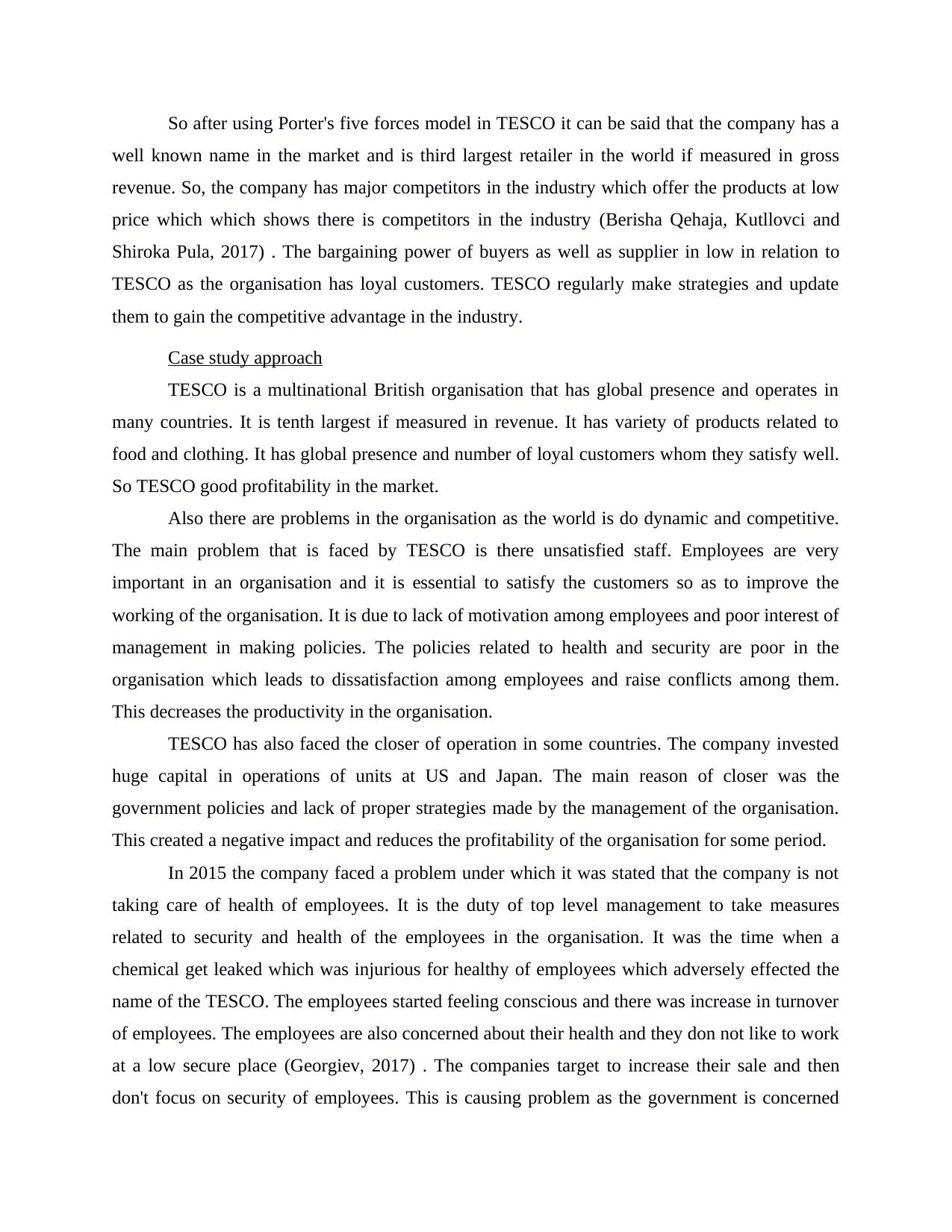
So after using Porter's five forces model in TESCO it can be said that the company has a
well known name in the market and is third largest retailer in the world if measured in gross
revenue. So, the company has major competitors in the industry which offer the products at low
price which which shows there is competitors in the industry (Berisha Qehaja, Kutllovci and
Shiroka Pula, 2017) . The bargaining power of buyers as well as supplier in low in relation to
TESCO as the organisation has loyal customers. TESCO regularly make strategies and update
them to gain the competitive advantage in the industry.
Case study approach
TESCO is a multinational British organisation that has global presence and operates in
many countries. It is tenth largest if measured in revenue. It has variety of products related to
food and clothing. It has global presence and number of loyal customers whom they satisfy well.
So TESCO good profitability in the market.
Also there are problems in the organisation as the world is do dynamic and competitive.
The main problem that is faced by TESCO is there unsatisfied staff. Employees are very
important in an organisation and it is essential to satisfy the customers so as to improve the
working of the organisation. It is due to lack of motivation among employees and poor interest of
management in making policies. The policies related to health and security are poor in the
organisation which leads to dissatisfaction among employees and raise conflicts among them.
This decreases the productivity in the organisation.
TESCO has also faced the closer of operation in some countries. The company invested
huge capital in operations of units at US and Japan. The main reason of closer was the
government policies and lack of proper strategies made by the management of the organisation.
This created a negative impact and reduces the profitability of the organisation for some period.
In 2015 the company faced a problem under which it was stated that the company is not
taking care of health of employees. It is the duty of top level management to take measures
related to security and health of the employees in the organisation. It was the time when a
chemical get leaked which was injurious for healthy of employees which adversely effected the
name of the TESCO. The employees started feeling conscious and there was increase in turnover
of employees. The employees are also concerned about their health and they don not like to work
at a low secure place (Georgiev, 2017) . The companies target to increase their sale and then
don't focus on security of employees. This is causing problem as the government is concerned
well known name in the market and is third largest retailer in the world if measured in gross
revenue. So, the company has major competitors in the industry which offer the products at low
price which which shows there is competitors in the industry (Berisha Qehaja, Kutllovci and
Shiroka Pula, 2017) . The bargaining power of buyers as well as supplier in low in relation to
TESCO as the organisation has loyal customers. TESCO regularly make strategies and update
them to gain the competitive advantage in the industry.
Case study approach
TESCO is a multinational British organisation that has global presence and operates in
many countries. It is tenth largest if measured in revenue. It has variety of products related to
food and clothing. It has global presence and number of loyal customers whom they satisfy well.
So TESCO good profitability in the market.
Also there are problems in the organisation as the world is do dynamic and competitive.
The main problem that is faced by TESCO is there unsatisfied staff. Employees are very
important in an organisation and it is essential to satisfy the customers so as to improve the
working of the organisation. It is due to lack of motivation among employees and poor interest of
management in making policies. The policies related to health and security are poor in the
organisation which leads to dissatisfaction among employees and raise conflicts among them.
This decreases the productivity in the organisation.
TESCO has also faced the closer of operation in some countries. The company invested
huge capital in operations of units at US and Japan. The main reason of closer was the
government policies and lack of proper strategies made by the management of the organisation.
This created a negative impact and reduces the profitability of the organisation for some period.
In 2015 the company faced a problem under which it was stated that the company is not
taking care of health of employees. It is the duty of top level management to take measures
related to security and health of the employees in the organisation. It was the time when a
chemical get leaked which was injurious for healthy of employees which adversely effected the
name of the TESCO. The employees started feeling conscious and there was increase in turnover
of employees. The employees are also concerned about their health and they don not like to work
at a low secure place (Georgiev, 2017) . The companies target to increase their sale and then
don't focus on security of employees. This is causing problem as the government is concerned
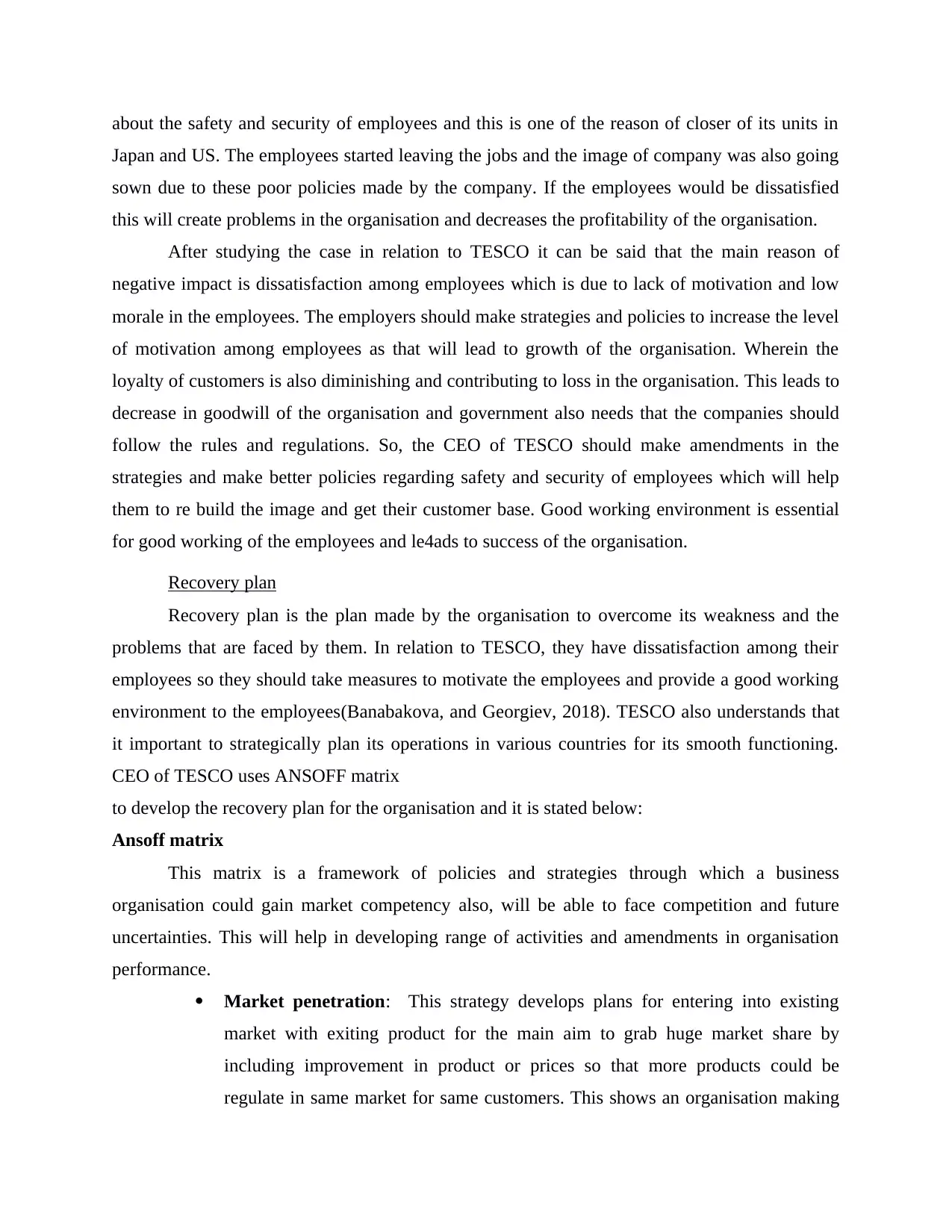
about the safety and security of employees and this is one of the reason of closer of its units in
Japan and US. The employees started leaving the jobs and the image of company was also going
sown due to these poor policies made by the company. If the employees would be dissatisfied
this will create problems in the organisation and decreases the profitability of the organisation.
After studying the case in relation to TESCO it can be said that the main reason of
negative impact is dissatisfaction among employees which is due to lack of motivation and low
morale in the employees. The employers should make strategies and policies to increase the level
of motivation among employees as that will lead to growth of the organisation. Wherein the
loyalty of customers is also diminishing and contributing to loss in the organisation. This leads to
decrease in goodwill of the organisation and government also needs that the companies should
follow the rules and regulations. So, the CEO of TESCO should make amendments in the
strategies and make better policies regarding safety and security of employees which will help
them to re build the image and get their customer base. Good working environment is essential
for good working of the employees and le4ads to success of the organisation.
Recovery plan
Recovery plan is the plan made by the organisation to overcome its weakness and the
problems that are faced by them. In relation to TESCO, they have dissatisfaction among their
employees so they should take measures to motivate the employees and provide a good working
environment to the employees(Banabakova, and Georgiev, 2018). TESCO also understands that
it important to strategically plan its operations in various countries for its smooth functioning.
CEO of TESCO uses ANSOFF matrix
to develop the recovery plan for the organisation and it is stated below:
Ansoff matrix
This matrix is a framework of policies and strategies through which a business
organisation could gain market competency also, will be able to face competition and future
uncertainties. This will help in developing range of activities and amendments in organisation
performance.
Market penetration: This strategy develops plans for entering into existing
market with exiting product for the main aim to grab huge market share by
including improvement in product or prices so that more products could be
regulate in same market for same customers. This shows an organisation making
Japan and US. The employees started leaving the jobs and the image of company was also going
sown due to these poor policies made by the company. If the employees would be dissatisfied
this will create problems in the organisation and decreases the profitability of the organisation.
After studying the case in relation to TESCO it can be said that the main reason of
negative impact is dissatisfaction among employees which is due to lack of motivation and low
morale in the employees. The employers should make strategies and policies to increase the level
of motivation among employees as that will lead to growth of the organisation. Wherein the
loyalty of customers is also diminishing and contributing to loss in the organisation. This leads to
decrease in goodwill of the organisation and government also needs that the companies should
follow the rules and regulations. So, the CEO of TESCO should make amendments in the
strategies and make better policies regarding safety and security of employees which will help
them to re build the image and get their customer base. Good working environment is essential
for good working of the employees and le4ads to success of the organisation.
Recovery plan
Recovery plan is the plan made by the organisation to overcome its weakness and the
problems that are faced by them. In relation to TESCO, they have dissatisfaction among their
employees so they should take measures to motivate the employees and provide a good working
environment to the employees(Banabakova, and Georgiev, 2018). TESCO also understands that
it important to strategically plan its operations in various countries for its smooth functioning.
CEO of TESCO uses ANSOFF matrix
to develop the recovery plan for the organisation and it is stated below:
Ansoff matrix
This matrix is a framework of policies and strategies through which a business
organisation could gain market competency also, will be able to face competition and future
uncertainties. This will help in developing range of activities and amendments in organisation
performance.
Market penetration: This strategy develops plans for entering into existing
market with exiting product for the main aim to grab huge market share by
including improvement in product or prices so that more products could be
regulate in same market for same customers. This shows an organisation making
⊘ This is a preview!⊘
Do you want full access?
Subscribe today to unlock all pages.

Trusted by 1+ million students worldwide
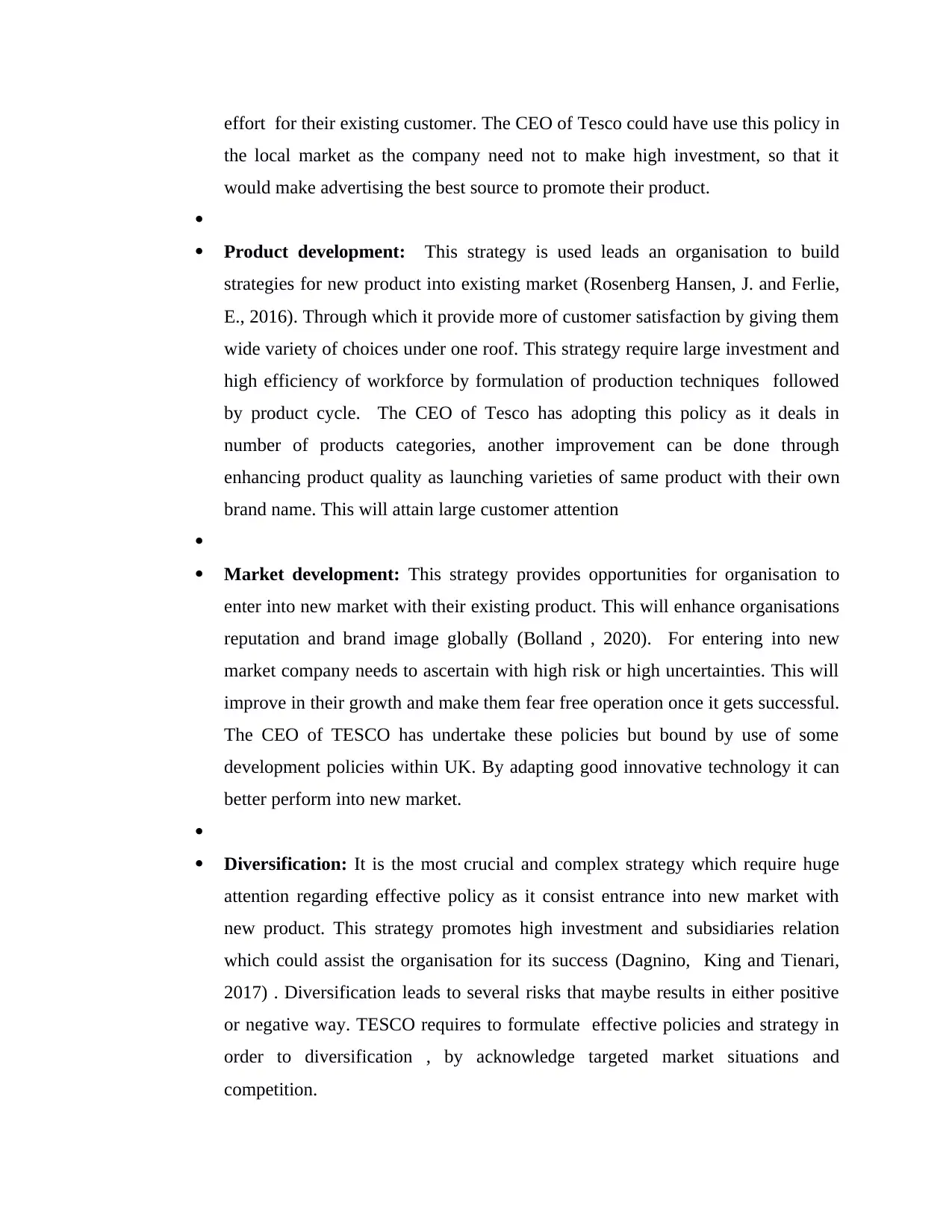
effort for their existing customer. The CEO of Tesco could have use this policy in
the local market as the company need not to make high investment, so that it
would make advertising the best source to promote their product.
Product development: This strategy is used leads an organisation to build
strategies for new product into existing market (Rosenberg Hansen, J. and Ferlie,
E., 2016). Through which it provide more of customer satisfaction by giving them
wide variety of choices under one roof. This strategy require large investment and
high efficiency of workforce by formulation of production techniques followed
by product cycle. The CEO of Tesco has adopting this policy as it deals in
number of products categories, another improvement can be done through
enhancing product quality as launching varieties of same product with their own
brand name. This will attain large customer attention
Market development: This strategy provides opportunities for organisation to
enter into new market with their existing product. This will enhance organisations
reputation and brand image globally (Bolland , 2020). For entering into new
market company needs to ascertain with high risk or high uncertainties. This will
improve in their growth and make them fear free operation once it gets successful.
The CEO of TESCO has undertake these policies but bound by use of some
development policies within UK. By adapting good innovative technology it can
better perform into new market.
Diversification: It is the most crucial and complex strategy which require huge
attention regarding effective policy as it consist entrance into new market with
new product. This strategy promotes high investment and subsidiaries relation
which could assist the organisation for its success (Dagnino, King and Tienari,
2017) . Diversification leads to several risks that maybe results in either positive
or negative way. TESCO requires to formulate effective policies and strategy in
order to diversification , by acknowledge targeted market situations and
competition.
the local market as the company need not to make high investment, so that it
would make advertising the best source to promote their product.
Product development: This strategy is used leads an organisation to build
strategies for new product into existing market (Rosenberg Hansen, J. and Ferlie,
E., 2016). Through which it provide more of customer satisfaction by giving them
wide variety of choices under one roof. This strategy require large investment and
high efficiency of workforce by formulation of production techniques followed
by product cycle. The CEO of Tesco has adopting this policy as it deals in
number of products categories, another improvement can be done through
enhancing product quality as launching varieties of same product with their own
brand name. This will attain large customer attention
Market development: This strategy provides opportunities for organisation to
enter into new market with their existing product. This will enhance organisations
reputation and brand image globally (Bolland , 2020). For entering into new
market company needs to ascertain with high risk or high uncertainties. This will
improve in their growth and make them fear free operation once it gets successful.
The CEO of TESCO has undertake these policies but bound by use of some
development policies within UK. By adapting good innovative technology it can
better perform into new market.
Diversification: It is the most crucial and complex strategy which require huge
attention regarding effective policy as it consist entrance into new market with
new product. This strategy promotes high investment and subsidiaries relation
which could assist the organisation for its success (Dagnino, King and Tienari,
2017) . Diversification leads to several risks that maybe results in either positive
or negative way. TESCO requires to formulate effective policies and strategy in
order to diversification , by acknowledge targeted market situations and
competition.
Paraphrase This Document
Need a fresh take? Get an instant paraphrase of this document with our AI Paraphraser
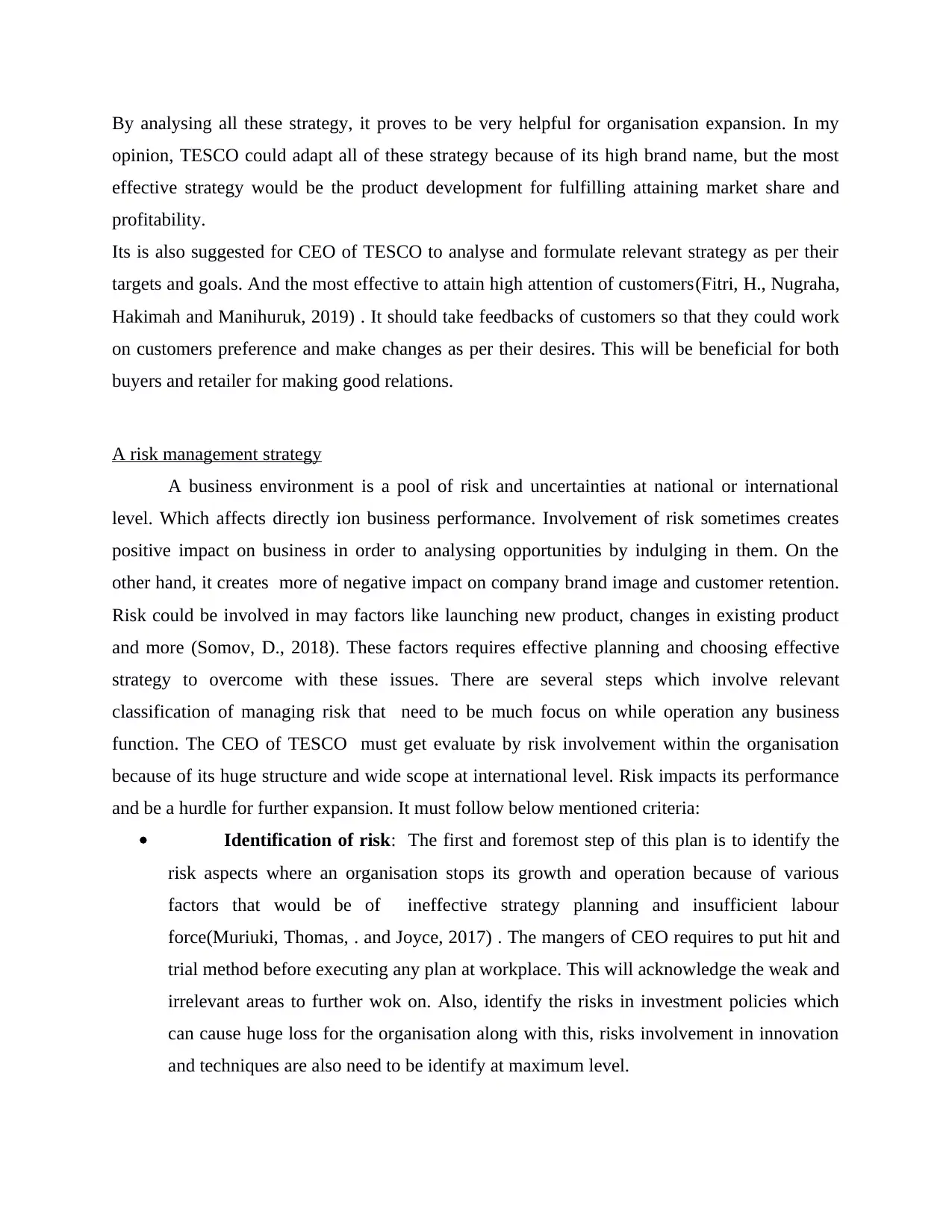
By analysing all these strategy, it proves to be very helpful for organisation expansion. In my
opinion, TESCO could adapt all of these strategy because of its high brand name, but the most
effective strategy would be the product development for fulfilling attaining market share and
profitability.
Its is also suggested for CEO of TESCO to analyse and formulate relevant strategy as per their
targets and goals. And the most effective to attain high attention of customers(Fitri, H., Nugraha,
Hakimah and Manihuruk, 2019) . It should take feedbacks of customers so that they could work
on customers preference and make changes as per their desires. This will be beneficial for both
buyers and retailer for making good relations.
A risk management strategy
A business environment is a pool of risk and uncertainties at national or international
level. Which affects directly ion business performance. Involvement of risk sometimes creates
positive impact on business in order to analysing opportunities by indulging in them. On the
other hand, it creates more of negative impact on company brand image and customer retention.
Risk could be involved in may factors like launching new product, changes in existing product
and more (Somov, D., 2018). These factors requires effective planning and choosing effective
strategy to overcome with these issues. There are several steps which involve relevant
classification of managing risk that need to be much focus on while operation any business
function. The CEO of TESCO must get evaluate by risk involvement within the organisation
because of its huge structure and wide scope at international level. Risk impacts its performance
and be a hurdle for further expansion. It must follow below mentioned criteria:
Identification of risk: The first and foremost step of this plan is to identify the
risk aspects where an organisation stops its growth and operation because of various
factors that would be of ineffective strategy planning and insufficient labour
force(Muriuki, Thomas, . and Joyce, 2017) . The mangers of CEO requires to put hit and
trial method before executing any plan at workplace. This will acknowledge the weak and
irrelevant areas to further wok on. Also, identify the risks in investment policies which
can cause huge loss for the organisation along with this, risks involvement in innovation
and techniques are also need to be identify at maximum level.
opinion, TESCO could adapt all of these strategy because of its high brand name, but the most
effective strategy would be the product development for fulfilling attaining market share and
profitability.
Its is also suggested for CEO of TESCO to analyse and formulate relevant strategy as per their
targets and goals. And the most effective to attain high attention of customers(Fitri, H., Nugraha,
Hakimah and Manihuruk, 2019) . It should take feedbacks of customers so that they could work
on customers preference and make changes as per their desires. This will be beneficial for both
buyers and retailer for making good relations.
A risk management strategy
A business environment is a pool of risk and uncertainties at national or international
level. Which affects directly ion business performance. Involvement of risk sometimes creates
positive impact on business in order to analysing opportunities by indulging in them. On the
other hand, it creates more of negative impact on company brand image and customer retention.
Risk could be involved in may factors like launching new product, changes in existing product
and more (Somov, D., 2018). These factors requires effective planning and choosing effective
strategy to overcome with these issues. There are several steps which involve relevant
classification of managing risk that need to be much focus on while operation any business
function. The CEO of TESCO must get evaluate by risk involvement within the organisation
because of its huge structure and wide scope at international level. Risk impacts its performance
and be a hurdle for further expansion. It must follow below mentioned criteria:
Identification of risk: The first and foremost step of this plan is to identify the
risk aspects where an organisation stops its growth and operation because of various
factors that would be of ineffective strategy planning and insufficient labour
force(Muriuki, Thomas, . and Joyce, 2017) . The mangers of CEO requires to put hit and
trial method before executing any plan at workplace. This will acknowledge the weak and
irrelevant areas to further wok on. Also, identify the risks in investment policies which
can cause huge loss for the organisation along with this, risks involvement in innovation
and techniques are also need to be identify at maximum level.
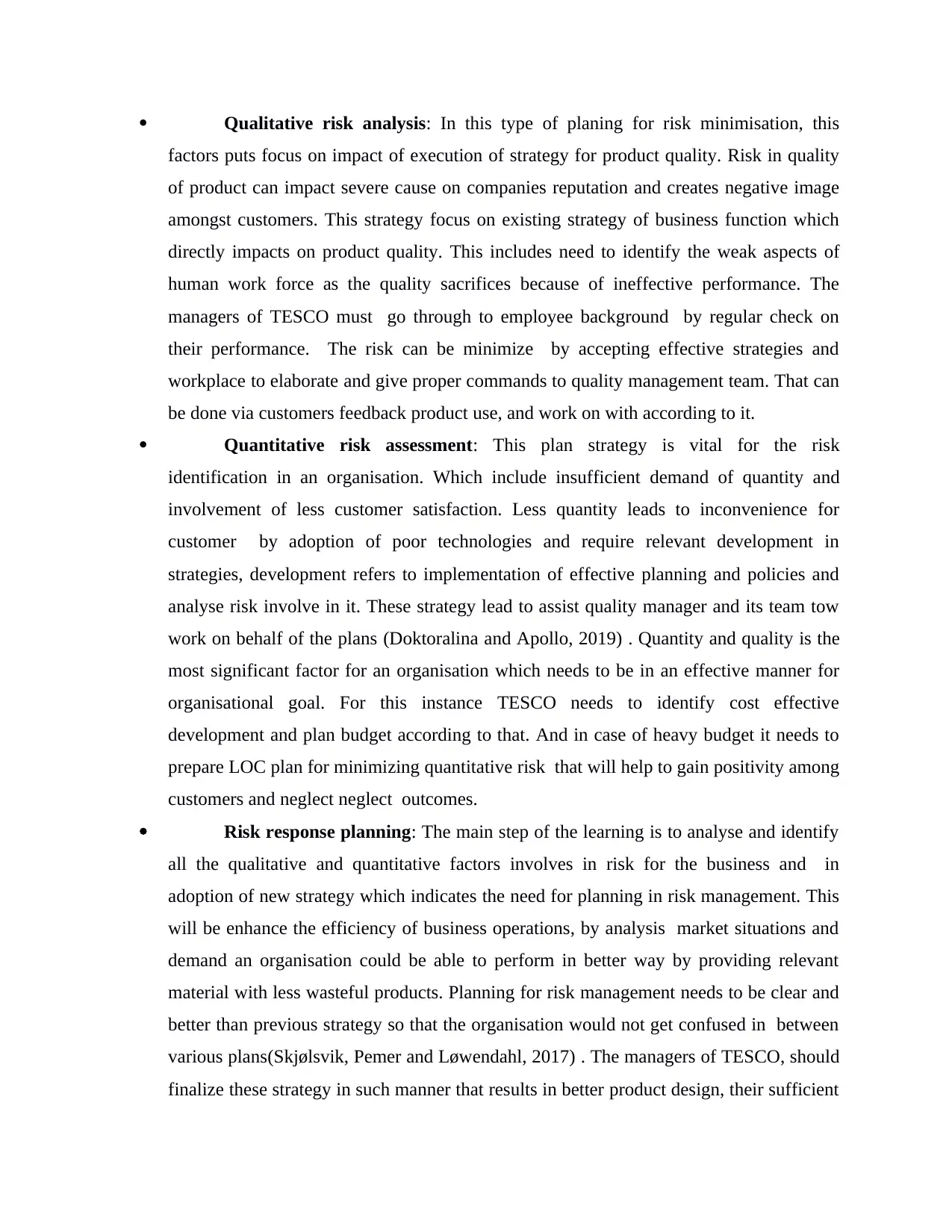
Qualitative risk analysis: In this type of planing for risk minimisation, this
factors puts focus on impact of execution of strategy for product quality. Risk in quality
of product can impact severe cause on companies reputation and creates negative image
amongst customers. This strategy focus on existing strategy of business function which
directly impacts on product quality. This includes need to identify the weak aspects of
human work force as the quality sacrifices because of ineffective performance. The
managers of TESCO must go through to employee background by regular check on
their performance. The risk can be minimize by accepting effective strategies and
workplace to elaborate and give proper commands to quality management team. That can
be done via customers feedback product use, and work on with according to it.
Quantitative risk assessment: This plan strategy is vital for the risk
identification in an organisation. Which include insufficient demand of quantity and
involvement of less customer satisfaction. Less quantity leads to inconvenience for
customer by adoption of poor technologies and require relevant development in
strategies, development refers to implementation of effective planning and policies and
analyse risk involve in it. These strategy lead to assist quality manager and its team tow
work on behalf of the plans (Doktoralina and Apollo, 2019) . Quantity and quality is the
most significant factor for an organisation which needs to be in an effective manner for
organisational goal. For this instance TESCO needs to identify cost effective
development and plan budget according to that. And in case of heavy budget it needs to
prepare LOC plan for minimizing quantitative risk that will help to gain positivity among
customers and neglect neglect outcomes.
Risk response planning: The main step of the learning is to analyse and identify
all the qualitative and quantitative factors involves in risk for the business and in
adoption of new strategy which indicates the need for planning in risk management. This
will be enhance the efficiency of business operations, by analysis market situations and
demand an organisation could be able to perform in better way by providing relevant
material with less wasteful products. Planning for risk management needs to be clear and
better than previous strategy so that the organisation would not get confused in between
various plans(Skjølsvik, Pemer and Løwendahl, 2017) . The managers of TESCO, should
finalize these strategy in such manner that results in better product design, their sufficient
factors puts focus on impact of execution of strategy for product quality. Risk in quality
of product can impact severe cause on companies reputation and creates negative image
amongst customers. This strategy focus on existing strategy of business function which
directly impacts on product quality. This includes need to identify the weak aspects of
human work force as the quality sacrifices because of ineffective performance. The
managers of TESCO must go through to employee background by regular check on
their performance. The risk can be minimize by accepting effective strategies and
workplace to elaborate and give proper commands to quality management team. That can
be done via customers feedback product use, and work on with according to it.
Quantitative risk assessment: This plan strategy is vital for the risk
identification in an organisation. Which include insufficient demand of quantity and
involvement of less customer satisfaction. Less quantity leads to inconvenience for
customer by adoption of poor technologies and require relevant development in
strategies, development refers to implementation of effective planning and policies and
analyse risk involve in it. These strategy lead to assist quality manager and its team tow
work on behalf of the plans (Doktoralina and Apollo, 2019) . Quantity and quality is the
most significant factor for an organisation which needs to be in an effective manner for
organisational goal. For this instance TESCO needs to identify cost effective
development and plan budget according to that. And in case of heavy budget it needs to
prepare LOC plan for minimizing quantitative risk that will help to gain positivity among
customers and neglect neglect outcomes.
Risk response planning: The main step of the learning is to analyse and identify
all the qualitative and quantitative factors involves in risk for the business and in
adoption of new strategy which indicates the need for planning in risk management. This
will be enhance the efficiency of business operations, by analysis market situations and
demand an organisation could be able to perform in better way by providing relevant
material with less wasteful products. Planning for risk management needs to be clear and
better than previous strategy so that the organisation would not get confused in between
various plans(Skjølsvik, Pemer and Løwendahl, 2017) . The managers of TESCO, should
finalize these strategy in such manner that results in better product design, their sufficient
⊘ This is a preview!⊘
Do you want full access?
Subscribe today to unlock all pages.

Trusted by 1+ million students worldwide
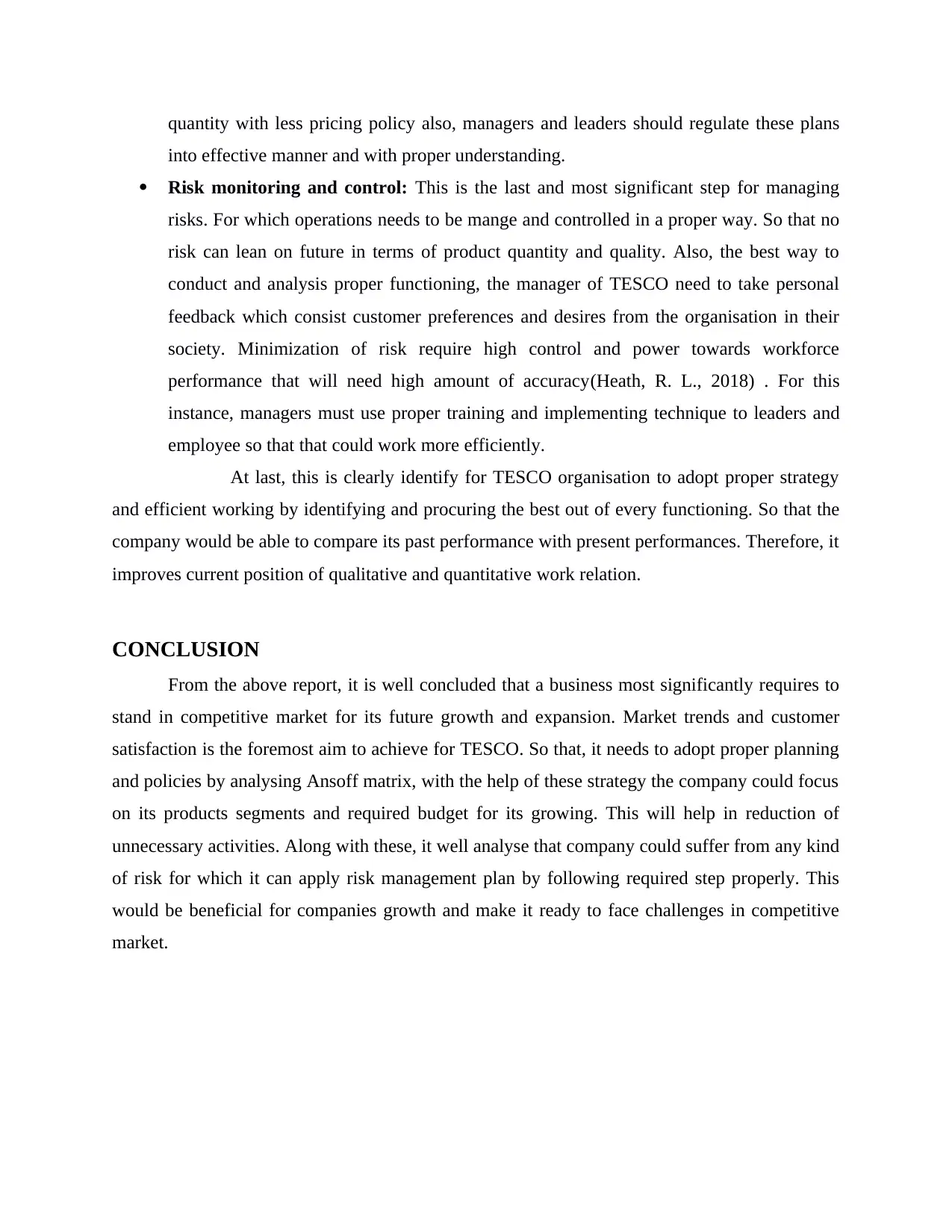
quantity with less pricing policy also, managers and leaders should regulate these plans
into effective manner and with proper understanding.
Risk monitoring and control: This is the last and most significant step for managing
risks. For which operations needs to be mange and controlled in a proper way. So that no
risk can lean on future in terms of product quantity and quality. Also, the best way to
conduct and analysis proper functioning, the manager of TESCO need to take personal
feedback which consist customer preferences and desires from the organisation in their
society. Minimization of risk require high control and power towards workforce
performance that will need high amount of accuracy(Heath, R. L., 2018) . For this
instance, managers must use proper training and implementing technique to leaders and
employee so that that could work more efficiently.
At last, this is clearly identify for TESCO organisation to adopt proper strategy
and efficient working by identifying and procuring the best out of every functioning. So that the
company would be able to compare its past performance with present performances. Therefore, it
improves current position of qualitative and quantitative work relation.
CONCLUSION
From the above report, it is well concluded that a business most significantly requires to
stand in competitive market for its future growth and expansion. Market trends and customer
satisfaction is the foremost aim to achieve for TESCO. So that, it needs to adopt proper planning
and policies by analysing Ansoff matrix, with the help of these strategy the company could focus
on its products segments and required budget for its growing. This will help in reduction of
unnecessary activities. Along with these, it well analyse that company could suffer from any kind
of risk for which it can apply risk management plan by following required step properly. This
would be beneficial for companies growth and make it ready to face challenges in competitive
market.
into effective manner and with proper understanding.
Risk monitoring and control: This is the last and most significant step for managing
risks. For which operations needs to be mange and controlled in a proper way. So that no
risk can lean on future in terms of product quantity and quality. Also, the best way to
conduct and analysis proper functioning, the manager of TESCO need to take personal
feedback which consist customer preferences and desires from the organisation in their
society. Minimization of risk require high control and power towards workforce
performance that will need high amount of accuracy(Heath, R. L., 2018) . For this
instance, managers must use proper training and implementing technique to leaders and
employee so that that could work more efficiently.
At last, this is clearly identify for TESCO organisation to adopt proper strategy
and efficient working by identifying and procuring the best out of every functioning. So that the
company would be able to compare its past performance with present performances. Therefore, it
improves current position of qualitative and quantitative work relation.
CONCLUSION
From the above report, it is well concluded that a business most significantly requires to
stand in competitive market for its future growth and expansion. Market trends and customer
satisfaction is the foremost aim to achieve for TESCO. So that, it needs to adopt proper planning
and policies by analysing Ansoff matrix, with the help of these strategy the company could focus
on its products segments and required budget for its growing. This will help in reduction of
unnecessary activities. Along with these, it well analyse that company could suffer from any kind
of risk for which it can apply risk management plan by following required step properly. This
would be beneficial for companies growth and make it ready to face challenges in competitive
market.
Paraphrase This Document
Need a fresh take? Get an instant paraphrase of this document with our AI Paraphraser
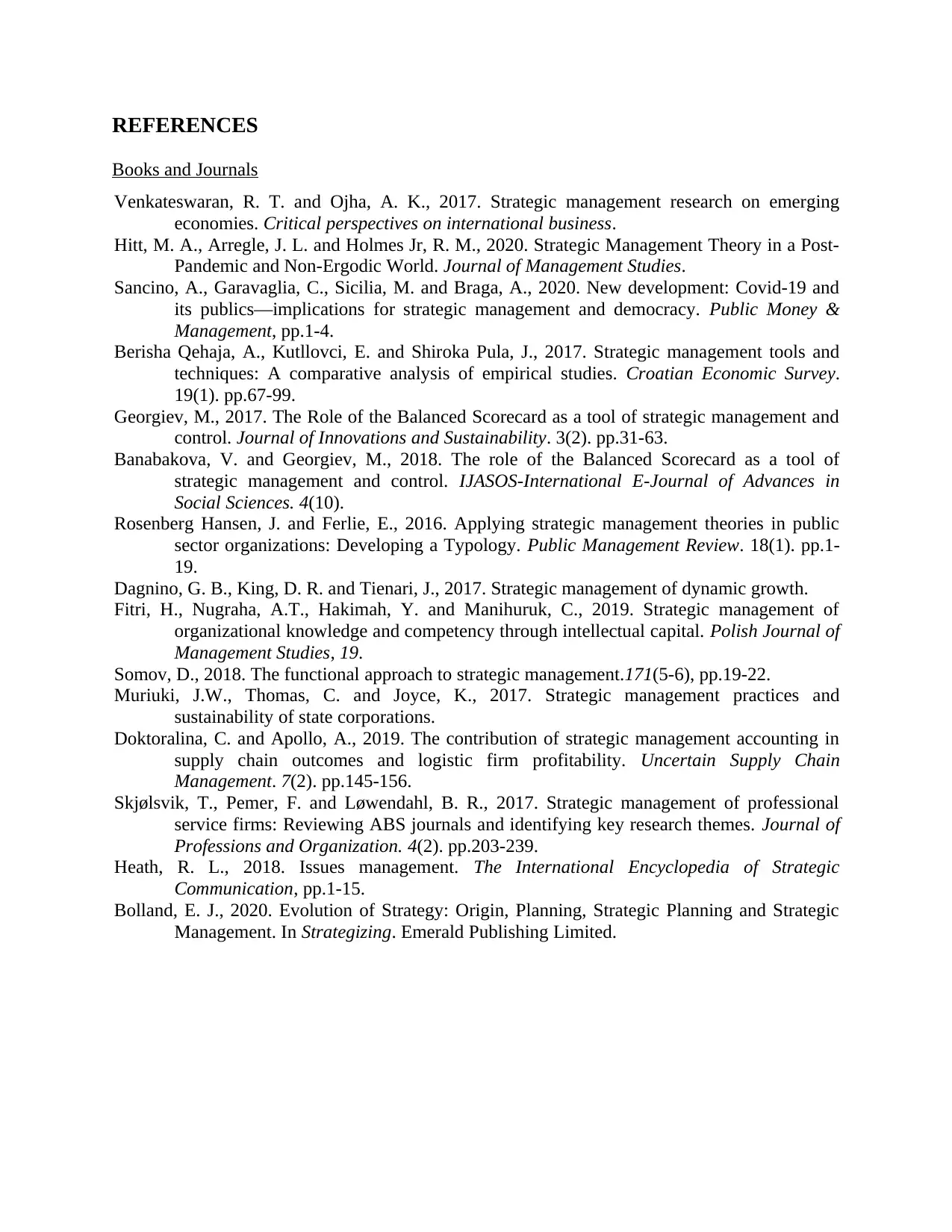
REFERENCES
Books and Journals
Venkateswaran, R. T. and Ojha, A. K., 2017. Strategic management research on emerging
economies. Critical perspectives on international business.
Hitt, M. A., Arregle, J. L. and Holmes Jr, R. M., 2020. Strategic Management Theory in a Post‐
Pandemic and Non‐Ergodic World. Journal of Management Studies.
Sancino, A., Garavaglia, C., Sicilia, M. and Braga, A., 2020. New development: Covid-19 and
its publics—implications for strategic management and democracy. Public Money &
Management, pp.1-4.
Berisha Qehaja, A., Kutllovci, E. and Shiroka Pula, J., 2017. Strategic management tools and
techniques: A comparative analysis of empirical studies. Croatian Economic Survey.
19(1). pp.67-99.
Georgiev, M., 2017. The Role of the Balanced Scorecard as a tool of strategic management and
control. Journal of Innovations and Sustainability. 3(2). pp.31-63.
Banabakova, V. and Georgiev, M., 2018. The role of the Balanced Scorecard as a tool of
strategic management and control. IJASOS-International E-Journal of Advances in
Social Sciences. 4(10).
Rosenberg Hansen, J. and Ferlie, E., 2016. Applying strategic management theories in public
sector organizations: Developing a Typology. Public Management Review. 18(1). pp.1-
19.
Dagnino, G. B., King, D. R. and Tienari, J., 2017. Strategic management of dynamic growth.
Fitri, H., Nugraha, A.T., Hakimah, Y. and Manihuruk, C., 2019. Strategic management of
organizational knowledge and competency through intellectual capital. Polish Journal of
Management Studies, 19.
Somov, D., 2018. The functional approach to strategic management.171(5-6), pp.19-22.
Muriuki, J.W., Thomas, C. and Joyce, K., 2017. Strategic management practices and
sustainability of state corporations.
Doktoralina, C. and Apollo, A., 2019. The contribution of strategic management accounting in
supply chain outcomes and logistic firm profitability. Uncertain Supply Chain
Management. 7(2). pp.145-156.
Skjølsvik, T., Pemer, F. and Løwendahl, B. R., 2017. Strategic management of professional
service firms: Reviewing ABS journals and identifying key research themes. Journal of
Professions and Organization. 4(2). pp.203-239.
Heath, R. L., 2018. Issues management. The International Encyclopedia of Strategic
Communication, pp.1-15.
Bolland, E. J., 2020. Evolution of Strategy: Origin, Planning, Strategic Planning and Strategic
Management. In Strategizing. Emerald Publishing Limited.
Books and Journals
Venkateswaran, R. T. and Ojha, A. K., 2017. Strategic management research on emerging
economies. Critical perspectives on international business.
Hitt, M. A., Arregle, J. L. and Holmes Jr, R. M., 2020. Strategic Management Theory in a Post‐
Pandemic and Non‐Ergodic World. Journal of Management Studies.
Sancino, A., Garavaglia, C., Sicilia, M. and Braga, A., 2020. New development: Covid-19 and
its publics—implications for strategic management and democracy. Public Money &
Management, pp.1-4.
Berisha Qehaja, A., Kutllovci, E. and Shiroka Pula, J., 2017. Strategic management tools and
techniques: A comparative analysis of empirical studies. Croatian Economic Survey.
19(1). pp.67-99.
Georgiev, M., 2017. The Role of the Balanced Scorecard as a tool of strategic management and
control. Journal of Innovations and Sustainability. 3(2). pp.31-63.
Banabakova, V. and Georgiev, M., 2018. The role of the Balanced Scorecard as a tool of
strategic management and control. IJASOS-International E-Journal of Advances in
Social Sciences. 4(10).
Rosenberg Hansen, J. and Ferlie, E., 2016. Applying strategic management theories in public
sector organizations: Developing a Typology. Public Management Review. 18(1). pp.1-
19.
Dagnino, G. B., King, D. R. and Tienari, J., 2017. Strategic management of dynamic growth.
Fitri, H., Nugraha, A.T., Hakimah, Y. and Manihuruk, C., 2019. Strategic management of
organizational knowledge and competency through intellectual capital. Polish Journal of
Management Studies, 19.
Somov, D., 2018. The functional approach to strategic management.171(5-6), pp.19-22.
Muriuki, J.W., Thomas, C. and Joyce, K., 2017. Strategic management practices and
sustainability of state corporations.
Doktoralina, C. and Apollo, A., 2019. The contribution of strategic management accounting in
supply chain outcomes and logistic firm profitability. Uncertain Supply Chain
Management. 7(2). pp.145-156.
Skjølsvik, T., Pemer, F. and Løwendahl, B. R., 2017. Strategic management of professional
service firms: Reviewing ABS journals and identifying key research themes. Journal of
Professions and Organization. 4(2). pp.203-239.
Heath, R. L., 2018. Issues management. The International Encyclopedia of Strategic
Communication, pp.1-15.
Bolland, E. J., 2020. Evolution of Strategy: Origin, Planning, Strategic Planning and Strategic
Management. In Strategizing. Emerald Publishing Limited.
1 out of 11
Related Documents
Your All-in-One AI-Powered Toolkit for Academic Success.
+13062052269
info@desklib.com
Available 24*7 on WhatsApp / Email
![[object Object]](/_next/static/media/star-bottom.7253800d.svg)
Unlock your academic potential
Copyright © 2020–2025 A2Z Services. All Rights Reserved. Developed and managed by ZUCOL.





